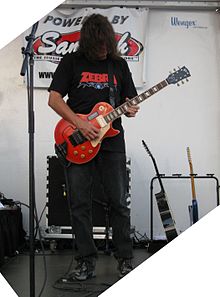Open G tuning

Among alternative tunings for the guitar, an open G tuning is an open tuning that features the G-major chord; its open notes are selected from the notes of a G-major chord, such as the G-major triad (G,B,D). For example, a popular open-G tuning is
- D-G-D-G-B-D (low to high).
An open-G tuning allows a G-major chord to be strummed on all six strings with neither fretting of the left hand nor a capo. Like other open tunings, it allows the eleven major chords besides G major each to be strummed by barring at most one finger on exactly one fret.[1] Open tunings are common in blues and folk music,[2] and they are used in the playing of slide and bottleneck guitars.[1][3]
Repetitive variants for special instruments

Repetitive open-G tunings are used by Russian guitars, Dobro guitars, and banjos. They repeat three open-string notes.
The repetitive open-G tuning
- D-G-B-D-G-B-D

is used by the Russian guitar, which has seven strings tuned mostly in major thirds.[4][5][6]
Dobros use a full six-string tuning with a bottom G: G-B-D-G-B-D, low to high. The two lowest strings are, accordingly, tuned three semitones higher for the lowest string (from E up to G) and two semitones higher for the second-lowest string (from A up to B), relative to standard tuning.
The 5-String Banjo's standard tuning is also an Open G: g-D-G-B-D, where the lower case "g" denotes the highest-pitched string, physically located next to (above) the lowest-pitched string, the first upper case "D".[7]
Overtones of the fundamental note G


Bad Company guitarist Mick Ralphs has used another open-G tuning, which listed the initial six overtones of the G note,
- G-G-D-G-B-D

for "Hey Hey" and while writing the demo of "Can't Get Enough".[8]
The overtones tuning G-G-D-G-B-D was used by Joni Mitchell for "Electricity", "For the Roses", and "Hunter (The Good Samaritan)".[9] Truncating this tuning to G-D-G-B-D for his five-string guitar, Keith Richards plays this overtones-tuning on The Rolling Stones's "Honky Tonk Women", "Brown Sugar" and "Start Me Up".[10]
See also
- Minor thirds tuning
- Scordatura, alternative tunings of stringed instruments
- Stringed instrument tunings
Notes
- ^ a b Sethares (2010, p. 16)
- ^ Denyer (1992, p. 158)
- ^ Denyer (1992, p. 160)
- ^ Bellow (1970, p. 164): Bellow, Alexander (1970). The illustrated history of the guitar. Colombo Publications.
{{cite book}}: Invalid|ref=harv(help) - ^ Timofeyev (1999): Timofeyev, Oleg V. (1999). The golden age of the Russian guitar: Repertoire, performance practice, and social function of the Russian seven-string guitar music, 1800-1850. Duke University, Department of Music. pp. 1–584. University Microfilms (UMI), Ann Arbor, Michigan, number 9928880.
{{cite book}}: Invalid|ref=harv(help) - ^ Ophee, Matanya (ed.). 19th Century etudes for the Russian 7-string guitar in G Op. The Russian Collection. Vol. 9. Editions Orphee. PR.494028230.
{{cite book}}: Invalid|ref=harv(help)Ophee, Matanya (ed.). Selected Concert Works for the Russian 7-String Guitar in G open tuning. The Russian Collection. Vol. 10 ("X"). Editions Orphee. PR.494028240.
{{cite book}}: Invalid|ref=harv(help) - ^ http://opendtuning.com/open-g-tuning-dgdgbd/
- ^ Sharken, Lisa (15 May 2001). "Mick Ralphs: The rock 'N' roll fantasy continues". Vintage Guitar. Retrieved 21 February 2013.
{{cite journal}}: Invalid|ref=harv(help) - ^ "List of all Guitar and Piano Transcriptions". GGDGBD. JoniMitchell.com. Retrieved February 22, 2013.
- ^ Ellis, Andy (2005). "How to play like ... Keith Richards". Guitar Player. (subscription required). Retrieved 24 March 2013.
{{cite journal}}: Invalid|ref=harv(help)
References
- Denyer, Ralph (1992). "Playing the guitar ('How the guitar is tuned', pp. 68–69, and 'Alternative tunings', pp. 158–159)". The guitar handbook. Special contributors Isaac Guillory and Alastair M. Crawford (Fully revised and updated ed.). London and Sydney: Pan Books. pp. 65–160. ISBN 0-330-32750-X.
- Sethares, William A. (2011). "Alternate tuning guide". Madison, Wisconsin: University of Wisconsin; Department of Electrical Engineering. 2010 PDF version by Bill Sethares. Retrieved 19 May 2012.
{{cite web}}: Invalid|ref=harv(help) - Weissman, Dick (2006). Guitar tunings: A comprehensive guide. Routledge. ISBN 9780415974417. LCCN 0415974410.
{{cite book}}: Invalid|ref=harv(help)
